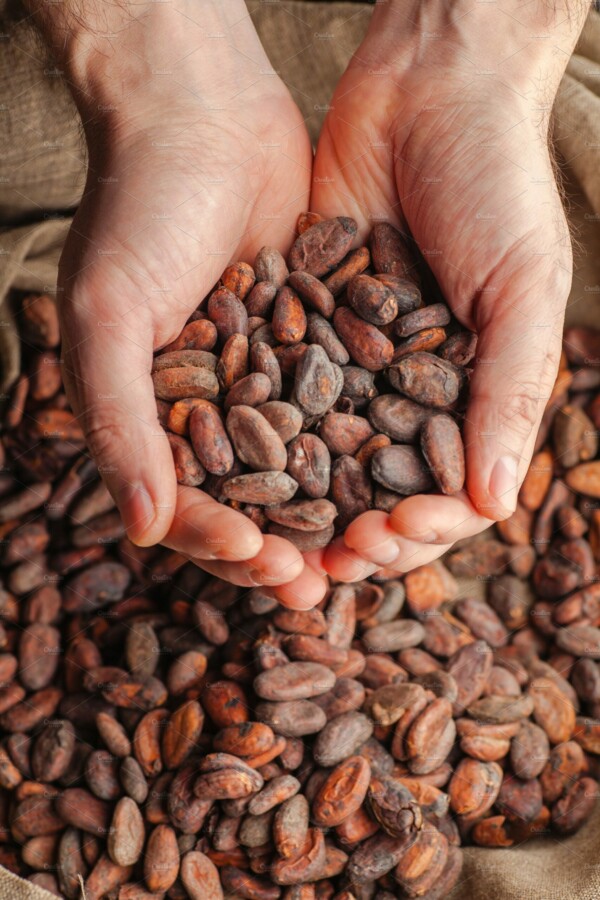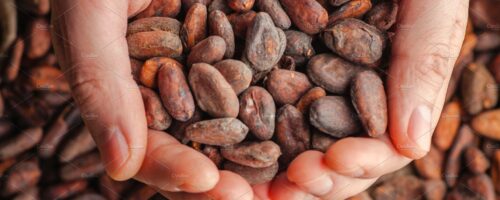
Ghana
How is it produced?
Cocoa is an agricultural crop that grows about twenty degrees north and south of the equator (Frame, 2017). West Africa grown 75% of it (Walters, 2021). In Ghana, West Africa, chocolate is produced by independent small farmers who cultivate cocoa beans growing on trees. Once the beans are ripe, the farmers crack the pods and harvest their white pulpy seeds to dry and process (Orla Ryan, 2011). Production includes two distinct processes: farming and turning the cocoa beans into chocolate.
Describe the supply chain to the store shelf in Canada:
Here follows an example the supply chain for chocolate, looking at sourcing within the country Ghana, which produces 21% of the world’s cocoa crop (Leissle, 2013). Ghana farmers grow over 650,000 tons annually of cocoa beans (Orla Ryan, 2011). The harvesters ferment the beans in wooden crates for up to 7 days, and then the beans are ready to be dried, after which they are loaded into big sacks and that is what is sent to the chocolate manufacturers (Hershey’s Chocolate, n.d.). The Ghanaian government sets the price that the farmers receive for their beans. There is a cocoa bean marketing board, who pay the farmers directly and then collect all the beans to sell them for the highest price (Orla Ryan, 2011). Ghana’s chocolate is considered the best bulk cocoa in the world and thus sells at a premium price, primarily to large chocolate makers (Leissle, 2013). Cocoa beans are sold to companies in North America and Europe, who import them most commonly by sea travel (Uygun, Jafri, & Choudhary, 2020). The supply chain from farm to mouth can be hard to track; however, some chocolate companies, such as Mars Wrigley Confectionary, have begun to require stricter tracking of the supply chain in order to reduce or eliminate deforestation (Thompson, 2019) and other practices such as child labour (Taraldsen & de Bassompierre, 2021). The chocolate company Nestle states their supply chain is 75% deforestation-free (Coyne, 2019). West African, including Ghana, chocolate is sold primarily to large companies, whereas, other chocolate sources such as Madagascar is sold to single-origin chocolate manufacturers, or luxury chocolatiers (Leissle, 2013).
Big chocolate companies purchase the cocoa from the government-run chocolate marketing boards in the supplier countries. Some countries such as Ivory Coast do not have a centralized chocolate board, so farmers must find ways to sell their cocoa independently. Companies import the cocoa beans to their manufacturing plants in North America and Europe where they are turned into chocolate bars. The manufacturers clean the beans, test the flavor and smell, then roast them to separate the shell from the bean kernel. This process creates the chocolate liquor, which is rotated through a conch machine to eliminate the bitter taste. Then the chocolate liquor is tempered and cooled until molded. (Hershey’s Chocolate, n.d.). Manufacturers, such as Hershey’s, create the chocolate products and release them for sale through distributors and retailers, which put the products on the store shelves, where they are then purchased by the end users who buy and consume them. (Hershey’s Chocolate, n.d.)
What is the power balance between the producer and seller?
The Ghanaian government through the chocolate board, starting in 1992, began organizing the sale of chocolate and standardized the minimum price that farmers received, which helped increase the farmer’s standards of living (Orla Ryan, 2011). The farmers get paid a pittance for their products and they do not get to eat the chocolate. Their standard of living has been improving because the government board has been slowly raising the prices that farmers receive, but many farmers’ families still do not have access to basic education for their children (Orla Ryan, 2011). The fair-trade movement tried to take credit for the increase in farmers’ wellbeing; however, it was the changing government towards democracy that increased the benefit for farmers (Orla Ryan, 2011). However, today cacao farmers earn less than 10% of the sale price of their product once turned into chocolate (Walters, 2021). Farmers in Ghana earn poverty wages of $0.40-$0.45 per day (Unlocking a Fairer Cocoa Supply Chain in West Africa, 2020). Farmers in the Global South earn less than $1.25 per day (Cocoa Prices and Income of Farmers, n.d.). The market price for cocoa has declined since the 1980s, but the multinational chocolate companies see continued increasing profits (Cocoa Prices and Income of Farmers, n.d.). Chocolate sales account for over 60% of the U.S. candy industry (Chocolate Industry Analysis 2020 – Cost & Trends, n.d.).
Can you recommend changes to the system to improve the balance?
The system in Ghana has already implemented some strategies to improve the situation for many farmers and their families, such as the creation of the cocoa board that helped farmers know they would receive a minimum payment for their work. The board also helps standardize the quality of exported beans, and has helped with the creation and distribution of “hybrid seeds that offer better yields in shorter time frames” (Ghana’s Cocoa Value Chain, 2021), which helps maintain the reputation of Ghanaian cocoa. Unfortunately, this same cocoa board limits the ability of individual farmers to access the world market and receive higher offers for their product from smaller purchasers who may be willing to pay more for a higher quality product.
One way to improve the power balance may be to allow farmers to deal directly with purchasers who want to make premium chocolate products. Such purchasers use their ethical purchasing practices in their marketing so that they can charge more for “ethical” chocolate products. It does not seem like it would be wise to completely deregulate the cocoa board, but allowing individual farmers some freedom in who they sell to might create an avenue for some farmers to make more profit. Another idea would be for each farmer to get the minimum price per ton, then once the board sells the cocoa on the world market it could distribute some of the profit made using it’s greater bargaining ability to sell at a higher price. There is an advantage to selling to larger companies in that the board does not have to waste a lot of time and energy on making deals with multiple small purchasers, but the disadvantage to such a method is one is forced to sell everything at the same price to a large buyer.
References/Resources:
Chocolate Industry Analysis 2020 – Cost & Trends. (n.d.). Retrieved July 20, 2021, from Franchise Help: https://www.franchisehelp.com/industry-reports/chocolate-industry-analysis-2020-cost-trends/
Cocoa Prices and Income of Farmers. (n.d.). Retrieved July 20, 2021, from Make Chocolate Fair: https://makechocolatefair.org/issues/cocoa-prices-and-income-farmers-0
Coyne, A. (2019). Nestle Declares Three-Quarters of its Supply Chain is Deforestation-Free. Aroq-Just-Food.com (Global News).
Frame, M. (2017). 20° of Flavor: Chocolate and Vanilla. Prepared Foods, 186(7), pp. 56-68.
Ghana’s Cocoa Value Chain. (2021, July 9). Retrieved from Asoko Insight: https://www.asokoinsight.com/content/market-insights/ghana-cocoa-value-chain
Hershey’s Chocolate. (n.d.). Retrieved July 20, 2021, from The Ohio State University: https://u.osu.edu/hersheycommoditychain/sample-page/
Leissle, K. (2013). Invisible West Africa: The Politics of Single Origin Chocolate. Gastronomica, 13(3), 22-31.
Orla Ryan. (2011). Chocolate Nations: Living and Dying for Coccoa in West Africa. Zed Books.
Taraldsen, L. E., & de Bassompierre, L. (2021, June 20). Child Labor in Cocoa Belt is Norway Wealth Fund’s Moral Dilemma. Bloomberg.com, pp. N.PAG., 1 p.
Thompson, A. (2019, May). Mars Wrigley Confectionary Takes New Actions to Move Toward Deforestation-Free Cocoa Supply Chain: Company Aims for Fully Traceable Cocoa Supply Chain by 2025. Candy Industry, 184(5), pp. 15-16.
Unlocking a Fairer Cocoa Supply Chain in West Africa. (2020). Confectionary Production, 86(8), p. 12.
Uygun, Y., Jafri, S., & Choudhary, A. (2020). Controlling the Risks in Sea Transportation of Cocoa Beans. Cogent Business & Management, 7(1), 1-17.
Walters, D. (2021). Cacao in a Changing Climate. In Chocolate Crisis (pp. 146-161). University of Florida Press.

